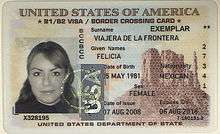Border Crossing Card

A Border Crossing Card (BCC) is an identity document as well as a B1/B2 visa that allows entry into the United States by Mexican citizens. As a standalone document, the BCC allows Mexican citizens to visit the border areas of the U.S. when entering by land or sea directly from Mexico for less than 72 hours.[1] The document also functions as a full B1/B2 visa when presented with a valid Mexican passport.[2] Section 104 of the United States Illegal Immigration Reform and Immigrant Responsibility Act of 1996 (IIRIRA) serves as the legal basis for the issuance of Border Crossing Cards.
Eligibility
The BCC is issued only to Mexican citizens residing in Mexico and by the U.S. diplomatic missions in Mexico.[3]
Description
The first generation of machine readable BCC's, known as "laser visas",[4] was produced from April 1, 1998, until September 30, 2008. The laminated, credit card-size document is both a BCC and a B1/B2 visitor’s visa. The cards are valid for travel until the expiration date on the front of the card, usually ten years after issuance. They are nearly identical to the previous generation Permanent Resident Card.
October 1, 2008, marked the beginning of production of a second generation B1/B2 visa/BCC. The new card is similar in size to the old BCC, but contains enhanced graphics and technology. The original BCC was produced by the now defunct Immigration and Naturalization Service but the current card is produced by the Department of State.[5] It is virtually identical to the Passport Card, which is issued to citizens and nationals of the United States for the purposes of land and sea border crossings, in its general design layout. The card includes an RFID chip and Integrated Contactless Circuit and is part of the same PASS System that the Passport Card belongs to.[6]
See also
References
- ↑ Frequently Asked Questions
- ↑ Border Crossing Card - Who can use it?
- ↑ Border Crossing Card
- ↑ http://www.traveldocs.com/us/er.htm#bcc
- ↑ United States Consulate, Monterrey, Mexico (October 1, 2008). "Updated U.S. Border Crossing Card Visa". Archived from the original on July 21, 2011. Retrieved February 8, 2011.
- ↑ ((US DHS, ICE, Forensic Document Laboratory)) (July 10, 2009). "Forensic Document Laboratory Alert, Counterfeit DSP-150's" (PDF). Retrieved February 8, 2011.